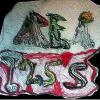Currently: Some days I’m full of energy; blissful and happy, other days I’m completely emotionless, spaced out and anxious. When I’m spaced out my social anxiety goes through the roof. My thoughts can be intrusive, in the way that I overthink social situations sometimes experiencing impending doom. I just want to cry. That’s why I’m so desperately trying to find a cure. I exercise heavily 4 to 5 days a week. I also eat well, quinoa, chia, grains, fruit, vegetables, meat twice a week, fish 2-3 times a week. After, my cannabis induced panic attack I quit cold turkey and started to take various nootropics/adaptogens to live with the burden of social anxiety and situational anxiety.
However, I’m back in college with my friends a few of who smoke cannabis religiously. I haven’t smoked cannabis in quite sometime, however, almost everyday I have been near people who are smoking cannabis and I have felt a 2nd hand smoke high.
BACKGROUND - 5 months from present: I’m 20 years of age, quite smoking cannabis a few months ago and I believe that I have developed a form of social anxiety. All throughout me teenage years, until about a year ago I was an extrovert. Very outgoing, with lots of charisma. However, I am now the complete opposite of that following my cannabis induced panic attack. I have not felt the same since and have become extremely introspective.
After my cannabis induced panic attack, I quit cold turkey and went to the doctors because I didn’t know who I was. My brain was in a fog, I could not concentrate, my eyesight was blurry and dull almost like I was looking through a film of grey, sounds were earsplitting, I had a full prickly rash all over my body, I had tingling in the fingers and an odd sensation in my left front-upper side of my head that resembled a void/black hole. I always felt it when I smoked but it didn’t seem to bother me until my panic attack. To cope with it I usually try to occupy myself with something or else the sensation will become too overwhelming. Nevertheless, Lyme disease was ruled out, although blood tests can oftentimes come back false negative. My doctor me to take vitamin D3 everyday.






















































